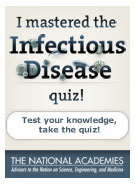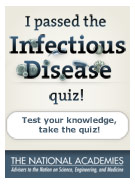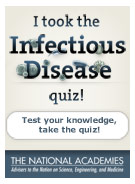
What You Need To Know About Infectious Disease
What do you know about infectious disease?
Which of the following diseases is NOT caused by a virus?
-
Sorry, that’s incorrect.
Tuberculosis is caused by a bacterial infection. Chicken pox, the common cold, and influenza are all caused by viral infections.
-
Sorry, that’s incorrect.
Tuberculosis is caused by a bacterial infection. Chicken pox, the common cold, and influenza are all caused by viral infections.
-
Sorry, that’s incorrect.
Tuberculosis is caused by a bacterial infection. Chicken pox, the common cold, and influenza are all caused by viral infections.
-
Correct!
Tuberculosis is caused by a bacterial infection. Chicken pox, the common cold, and influenza are all caused by viral infections.
Which of the following is not a viral disease:
-
Sorry, that’s incorrect.
Trichinosis is not a viral disease. It is caused by a helminth (parasitic worm) found in undercooked meat, not by a virus.
-
Sorry, that’s incorrect.
Trichinosis is not a viral disease. It is caused by a helminth (parasitic worm) found in undercooked meat, not by a virus.
-
Correct!
Trichinosis is not a viral disease. It is caused by a helminth (parasitic worm) found in undercooked meat, not by a virus.
About how much of its fish and seafood does the United States import?
-
Sorry, that’s incorrect.
The United States imports more than 80 percent of its fish and seafood. About 20 percent of its fresh vegetables and 50 percent of its fresh fruits are imported. As wealthy nations demand such foods year-round, the increasing reliance on producers abroad means that food may be contaminated during harvesting, storage, processing, and transport—long before it reaches overseas markets.
-
Sorry, that’s incorrect.
The United States imports more than 80 percent of its fish and seafood. About 20 percent of its fresh vegetables and 50 percent of its fresh fruits are imported. As wealthy nations demand such foods year-round, the increasing reliance on producers abroad means that food may be contaminated during harvesting, storage, processing, and transport—long before it reaches overseas markets.
-
Correct!
The United States imports more than 80 percent of its fish and seafood. About 20 percent of its fresh vegetables and 50 percent of its fresh fruits are imported. As wealthy nations demand such foods year-round, the increasing reliance on producers abroad means that food may be contaminated during harvesting, storage, processing, and transport—long before it reaches overseas markets.
Which of the following is a bacterial infection?
-
Sorry, that’s incorrect.
Strep throat is a bacterial infection. Hookworm is caused by a parasite and chickenpox and influenza are both caused by viruses.
-
Sorry, that’s incorrect.
Strep throat is a bacterial infection. Hookworm is caused by a parasite and chickenpox and influenza are both caused by viruses.
-
Correct!
Strep throat is a bacterial infection. Hookworm is caused by a parasite and chickenpox and influenza are both caused by viruses.
-
Sorry, that’s incorrect.
Strep throat is a bacterial infection. Hookworm is caused by a parasite and chickenpox and influenza are both caused by viruses.
Which of the following can be treated with antibiotics?
-
Sorry, that’s incorrect.
Strep throat is a bacterial infection that can be treated with antibiotics. The common cold and influenza are both viral infections, which do not respond to antibiotics. Antivirals may be prescribed instead.
-
Correct!
Strep throat is a bacterial infection that can be treated with antibiotics. The common cold and influenza are both viral infections, which do not respond to antibiotics. Antivirals may be prescribed instead.
-
Sorry, that’s incorrect.
Strep throat is a bacterial infection that can be treated with antibiotics. The common cold and influenza are both viral infections, which do not respond to antibiotics. Antivirals may be prescribed instead.
-
Sorry, that’s incorrect.
Strep throat is a bacterial infection that can be treated with antibiotics. The common cold and influenza are both viral infections, which do not respond to antibiotics. Antivirals may be prescribed instead.
Of the more than 1,700 known viruses, bacteria, and other pathogens that infect people, how many have come from animals?
-
Sorry, that’s incorrect.
More than half of the known pathogens that infect people have come from animals. Of the 37 new infectious diseases identified in just the past 30 years, two-thirds sprang from animals.
-
Sorry, that’s incorrect.
More than half of the known pathogens that infect people have come from animals. Of the 37 new infectious diseases identified in just the past 30 years, two-thirds sprang from animals.
-
Correct!
More than half of the known pathogens that infect people have come from animals. Of the 37 new infectious diseases identified in just the past 30 years, two-thirds sprang from animals.
True or False: Scientists believe that hot weather may speed up both the breeding cycle of mosquitoes and replication of the virus in insects’ guts.
-
Correct!
Scientists believe that hot weather may speed up both the breeding cycle of mosquitoes and replication of the virus in insects’ guts.
-
Sorry, that’s incorrect.
Scientists believe that hot weather may speed up both the breeding cycle of mosquitoes and replication of the virus in insects’ guts.
Which of the following is an effective way to protect yourself against infectious disease?
- Keep immunizations up to date
- Wash your hands often
- Prepare and handle food carefully
- All of the above
-
Sorry, that’s incorrect.
All of the above can help prevent infectious disease. Other behaviors, such as exercising caution around wild and unfamiliar domestic animals, avoiding insect bites, practicing safe sex, and being vigilant about disease threats while traveling abroad, can also reduce the risk of infection.
-
Sorry, that’s incorrect.
All of the above can help prevent infectious disease. Other behaviors, such as exercising caution around wild and unfamiliar domestic animals, avoiding insect bites, practicing safe sex, and being vigilant about disease threats while traveling abroad, can also reduce the risk of infection.
-
Sorry, that’s incorrect.
All of the above can help prevent infectious disease. Other behaviors, such as exercising caution around wild and unfamiliar domestic animals, avoiding insect bites, practicing safe sex, and being vigilant about disease threats while traveling abroad, can also reduce the risk of infection.
-
Correct!
All of the above can help prevent infectious disease. Other behaviors, such as exercising caution around wild and unfamiliar domestic animals, avoiding insect bites, practicing safe sex, and being vigilant about disease threats while traveling abroad, can also reduce the risk of infection.
True or False: Washing your hands with soaps that have residue-producing antibacterial products, such as those containing the chemical triclosan, have been proven to confer health benefits.
-
Sorry, that’s incorrect.
Washing with regular soap is considered the most important way to prevent disease transmission. Routine consumer use of residue-producing antibacterial products has no added benefit and may actually contribute to antibiotic resistance.
-
Correct!
Washing with regular soap is considered the most important way to prevent disease transmission. Routine consumer use of residue-producing antibacterial products has no added benefit and may actually contribute to antibiotic resistance.
Thank you for taking our quiz.
Place this badge on your Facebook page to show your friends what you know about infectious disease.
Place this badge on your Facebook page to show your friends what you know about infectious disease.
OR, get a higher score to unlock a different badge.
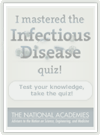
Place this badge on your Facebook page to show your friends what you know about infectious disease.
OR, get a higher score to unlock a different badge.
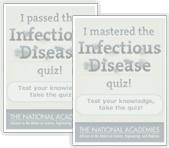
Explore Other Topics
Disease Watchlist
Infectious Disease Defined
- Cell Membrane
A semipermeable barrier that separates the interior of a cell from the external environment.
